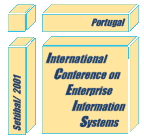 Tutorials
Tutorials Tutorials
Tutorials
| Tutorial 1 |
| Business Data Warehousing in Enterprise Management |
 |
Dr. Satya P. Chattopadhyay Web Page - http://academic.scranton.edu/faculty/SPC354/ |
The objective of Business Data Warehousing (BDW) implementation in the context of enterprise management is to standardize the structure and representation of all enterprise information, making them accessible from a single point of entry. BDW seeks to provide stand alone report generation and facilitate sophisticated analysis in a fast and cost-effective manner. The system also supports acquisition of data from a wide range of external databases and on-line sources in addition to internal data including legacy systems. Decision-makers can query the system to obtain historical as well as current information. A demonstration of the Business Information Warehouse (BW) in SAP R/3 environment will be included.
Brief Bio of Dr. Satya P. Chattopadhyay
Dr. Chattopadhyay teaches Enterprise Management, International Marketing, and Marketing Research at the Arthur J. Kania School of Management at the University of Scranton. In addition to his teaching and research, Dr. Chattopadhyay is active in international aid projects involving quality management and enterprise management technology. In the last three years Dr. Chattopadhyay has worked on international development projects with USAID, USIA, Swiss Development Corporation, World Bank, in Vietnam, Kyrgyzstan, Slovakia, Kazakhstan, and Republic of Georgia. Dr. Chattopadhyay is a member of the 4-person SAP team at the Arthur J. Kania School of Management of the University of Scranton. With extensive training in SAP R/3 business re-engineering, sales and distribution and service management modules he is currently involved data warehousing and e-commerce aspects of enterprise management.
| Tutorial 2 |
| Organisational Memories for Capturing, Sharing and Utilizing Knowledge |
 |
Dr. Ulrich Reimer Swiss Life,
Information Systems Research Group Email - Ulrich.Reimer@swisslife.ch Web Page - http://research.swisslife.ch/~reimer/ |
General:
In the context of Knowledge Management the topic of organisational
memories has got more and more attention. In analogy to human
memory the term means that organisations have a memory, too,
which allows them to pursue their tasks with the necessary
efficiency, effectiveness, and consistency over time, as well as
to learn from experiences made to be able to adapt to an ever
changing environment.
Part of the organisational memory are, among others, the people
working in the organisation, documents (in paper or electronic
form), data bases, as well as regulations of how things are to be
done. The latter are often implicit in the business processes.
This tutorial deals with the IT aspects of organisational
memories, i.e., how to support the capturing, preservation,
sharing, and utilization by IT means. The electronic repository
holding the represented knowledge together with the information
systems which offer the above functionalities are called an
Organisational Memory System.
Structure:
1. Definition and Role of an Organizational Memory
2. Generic Architecture of an Organizational Memory System
3. Knowledge Integration, Sharing, and Reuse
4. Entering Knowledge into an Organizational Memory
5. Utilizing Organizational Memories
6. Outlook
Brief Bio of Dr. Ulrich Reimer
Dr. Ulrich Reimer teaches Intelligent Systems for Knowledge Management, which include topics like Organizational Memory Systems, Decision Support Systems, Process Management, Ontologies at the Dept. of Mathematics and Computer Science at the University of Konstanz. In the past he gave courses on Knowledge Representation, Machine Learning, Intelligent Information Systems, Database Systems. In addition to his teaching and research, Dr. Reimer has been Scientific coordinator of an SPP project on knowledge base management systems with the Swiss Federal Institute of Technology (ETH) Zurich, (Co-)Chair of the international conferences on "Practical Aspects of Knowledge Management", PAKM96, PAKM98, and PAKM2000 in Basel, Switzerland. He is currently the head of IT Research & Development at Swiss Life, Zurich.
| Tutorial 3 |
| Wireless Application programming with Java |
 |
Dr. Qusay Mahmoud Carleton University Email - qmahmoud@javacourses.com Web Page - http://www.scs.carleton.ca/~qmahmoud/ |
Most Internet technologies are designed for desktop and large computers running on reliable networks with relatively high bandwidth. Hand-held wireless devices, on the other hand, have a more constrained computing environment. They tend to have less memory, less powerful CPUs, different input devices, and smaller displays. The Wireless Application Protocol (or WAP), which is a specification developed by the WAP Forum, takes advantage of the several data-handling approaches already in use. Developing wireless applications using WAP technologies is similar to developing web pages with a markup language because it is browser based.
Another approach
to developing wireless applications is to use the J2ME Mobile
Information Device Profile (MIDP).
With either WAP or MIDP, the Java programming language plays an important
role. In WAP, Java Servlets and Java Server Pages (JSPs) can be used to
generate Wireless Markup Language (WML) pages dynamically, and in MIDP,
applications (also called MIDlets) are written in Java.
This tutorial explores the various technologies that can be used to
develop wireless applications using Java. The tutorial will help
participants understand the technologies involved and how to use them.
The list of major topics to be covered in this tutorial includes:
- Handheld Device Markup Language (HDML)
- Compact HTML (cHTML)
- Wireless Application Protocol (WAP)
- Java 2 Micro Edition (J2ME)
- Kilo Virtual Machine (KVM)
- Connected Limited Device Configuration (CLDC)
- Mobile Information Device profile (MIDP)
- Palm Programming with Java
- Security Issues
- Useful Resources
Brief Bio of Dr. Qusay Mahmoud
Qusay H. Mahmoud provides Java consulting and training services. He has published dozens of articles on the Java programming language, including the MIDP and Palm programming articles for Sun Microsystems Java Developer Connection. He moderates the Device Programming forum for ITWorld.com. This term (Winter 2001) he is teaching a graduate course on Network Computing at Carleton University. Qusay is the author of Distributed Programming with Java (Manning Publications, 1999).
Page Updated on 10-10-2001